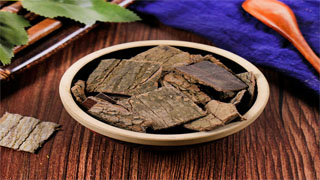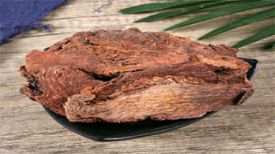
1. Aliases
Sichuan Eucommia ulmoides, Silian skin, pulled silk skin, Sixian, Sizhong, Yusi skin, silk cotton skin.2. Plant morphology
Deciduous trees. Up to 20 meters high, the bark, leaves, and fruits are broken and have white gum threads. The bark is gray brown, rough, and the tender branches have yellow brown hair, which soon becomes bald. Leaves alternate, with a petiole length of 1-2 centimeters; The leaves are elliptical, ovate, or rectangular in shape, with a thin leather like texture. The apex is gradually pointed, and the base is circular or broadly wedge-shaped. The edges are serrated. Flowers solitary at the base of the current year's branches, unisexual, dioecious, without perianth; Male flower bracts are obovate and spoon shaped, with 5-10 stamens. Female flower bracts are obovate, the ovary is hairless, flat and long, and the apex is 2-lobed. The samara is flat, long elliptical, with a 2-lobed apex and a wedge-shaped base. The flowering period is from April to May, and the fruiting period is from September to October.
3. Origin distribution
Born in mountainous forests or cultivated. Distributed in Sichuan, Shaanxi, Gansu and other regions.
4. Harvesting and processing
Peel from April to June, scrape off the rough skin, stack and sweat until the endothelium turns purple brown, and dry in the sun.
5. Characteristics of medicinal herbs
Plate shaped or slightly inward rolled on both sides, of varying sizes, with a thickness of 3-7 millimeters. The outer surface is light brown or grayish brown, with obvious wrinkles or longitudinal grooves. Some trees have thin bark without removing coarse bark, and obvious pores can be seen. The inner surface is dark purple and smooth. Brittle in texture, easily broken, and connected by fine, silver white, and elastic rubber threads on the cross-section. Mild in flavor and slightly bitter in taste.
6. Nature, taste, and meridian tropism
Warm in nature and sweet in taste. Return to the liver and kidney meridians.
7. Effect and function
Nourishing liver and kidney, strengthening muscles and bones, and promoting fetal safety. A Yang tonifying medicine belonging to the subcategory of tonifying deficiency medicine.
8. Clinical applications
Dosage 6-9 grams, decoct, soak in wine, or dissolve into pills. Used to treat kidney deficiency, lower back pain, weakness of muscles and bones, pregnancy bleeding, fetal restlessness, and hypertension.
9. Pharmacological research
Has a blood pressure lowering effect; Enhance the body's immune function; Affects the function of the pituitary adrenal cortex system; Has an inhibitory effect on the ex vivo uterus; Has a diuretic effect; It has obvious analgesic and anti-inflammatory effects. Pharmacological experiments have shown that water extracts of skin and leaves, as well as alcohol extracts, have acute hypotensive and vasodilatory effects.
10. Chemical composition
Contains components such as rosin alcohol diglucoside, D-syringal resin phenol, Eucommia ulmoides glycoside, Eucommia ulmoides extract A, and red dihydroxydehydrodipine berberine. In recent years, there has been a saying that the bark of branches contains twenty-nine alkanes, twenty-eight alcohols, beta sitosterol, betulinic acid, betulinic acid, and ursolic acid.
11. Taboos for use
Those with yin deficiency and excessive fire should take medication with caution.
12. Compatibility prescription
① Treatment of nephritis: 30 grams of Eucommia ulmoides and 30 grams of Salicornia ulmoides, stewed with pork. (Fujian Pharmacopoeia)
② To treat wind cold injury to the kidneys and lower back pain, do not bend or stretch: 1 pound of Eucommia ulmoides (cut, made with ginger juice, stir fried to remove any shreds). Soak three liters of ashless wine for ten days. Serve two or three times a day, and four or five times a day. (Du Zhong wine in "San Yin Fang")
③ Treating women with fetal distress: Eucommia ulmoides is not worth much (removing rough skin, filing fine files, and baking on tiles). Crush Luo into powder, cook jujube meat paste balls, as big as marbles. Take one pill each, chew it well, and add glutinous rice soup. (Eucommia ulmoides pills in the "Records of Saint Ji")
④ Treatment for hypertension: a. 12g of raw Eucommia ulmoides, 15g of mulberry parasitic, 18g of raw oysters, 9g of white chrysanthemum, and 9g of goji berries. Boiled in water. (Shandong Chinese Herbal Medicine Handbook); b. 15 grams each of Eucommia ulmoides, Scutellaria baicalensis, and Prunella vulgaris. Boiled in water. (Shaanxi Chinese Herbal Medicine)
⑤ To treat wind deficiency and excessive sweating, especially when lying down at night: 60 grams of Eucommia ulmoides (peeled, roasted, filed), 90 grams of Astragalus membranaceus (filed), and 90 grams of oysters (calcined red), and 15 grams of Mahuang root. The four flavors are finely dispersed by pounding. Take 6 grams per serving, stir fry the fan soup and adjust it. After eating, take it twice a day. (Du Zhong San in "Shengji Zonglu")
The content of the article is for clinical reference only. Non professionals in traditional Chinese medicine are not allowed to try medication.


